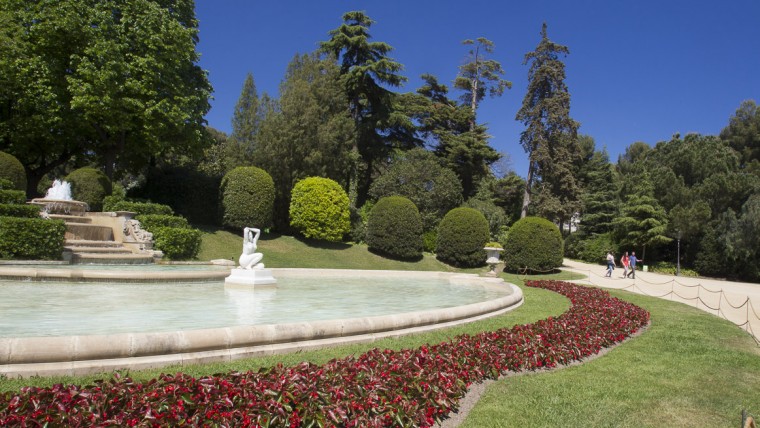
Behind a 250-metre-long wall covered to overflowing with bougainvilleas lie Barcelona’s most majestic gardens: the Jardins del Palau Reial de Pedralbes. Both French and English in style, a touch Romantic and very luxuriant, they take you back to a time where splendour and majesty were key landscape features.
When you pass through the magnificent wrought-iron entrance gate you are greeted by a large space, at the centre of which lies an oval-shaped pool with a sculpture of a woman in the middle.

History
The park came about as a result of a fire which, on Christmas Day in 1875, destroyed the 17th-century building on the Pla de Palau that had been the residence of Spain’s royal family during their visits to the city. The new royal residence, promoted in 1921 by the then mayor of Barcelona, Joan Antoni Güell, was built on land owned and ceded by the Güell family, where there was a mansion that had been restored.
The mayor handed over the new residence to King Alfonso XIII in 1926. When the Second Republic was declared in 1931, Spain’s treasury minister donated the palace and its gardens to the City Council, which opened them up to the city, with the royal premises becoming the Museu d’Arts Decoratives. The Residència Internacional de Senyoretes Estudiants (International Residence for Female Students) was established on the building’s second floor.
The City Council handed over the building and its gardens to the Generalitat of Catalonia in 2004, and it is now used for official ceremonies and receptions.

Art and Architecture
There are unique features all around the gardens. The pool at the entrance to the grounds is dominated by a marble nude female figure, Mediterrània (Mediterranean, 1962), created by Eulàlia Fàbregas de Sentmenat. Inside the park you will find Enric Casanovas’ bronze statue, Nu (Nude, 1930), which represents a woman standing, half naked. Outside there are stone sculptures created by a variety of sculptors between 1928 and 1929: Àngel Tarrach’s Figura femenina (Female Figure); Jaume Otero’s Al·legoria de Tarragona (Tarragona Allegory); Manuel Fuxà’s allegory dedicated to Lleida, Agricultura (Agriculture); two female figures, one by Josep Llimona and the other by Enric Casanovas, and Marina, an allegorical female figure representing fishing, by Eusebi Arnau. The most outstanding, however, on the grassy area next to the palace is Joan Borrell i Nicolau’s sculpture, Nu femení agenollat (Female Nude Kneeling, 1916).
A sculpture by Agapit Vallmitjana i Barbany, depicting Isabel II holding up her son Alfonso XII in her arms (1861), dominates the square overlooking the palace. Other sculptures in the background add the finishing touches to the ornamentation in this part of the gardens.
In the little bamboo wood there is the Font d’Hèrcules, a stone and wrought-iron fountain designed by Antoni Gaudí (1884). For many years it was hidden by the vegetation and it was only rediscovered in 1984, when the site was undergoing a major clean-up.
-
- Phone number
- Tel.: 010
-
- Accessibility
- Accessible for people with physical disabilities
-
- Titularity
- Public center
- Address:
- Av Diagonal, 686
- Districte:
- Les Corts
- Neighborhood:
- Pedralbes
- City:
- Barcelona
Timetable
| Periode | Dies | Hores |
|---|---|---|
| de l'1 de novembre al 31 de març |
Cada dia | de 10:00 h a 19:00 h |
| de l'1 d'abril al 31 d'octubre |
de 10.00 h a 20.00 h |
Abans tenien un horari de tancament aproximat, en funció de l'horari solar
(tancaven quan es feia fosc, al capvespre).
Tanquen quan es celebren actes institucionals en el Palau.
Esdeveniments
-
Concert "Level 42" Open in a new window
11/07/2025
-
Concert "The Human League" Open in a new window
16/07/2025
-
Concert "Chiara Oliver" Open in a new window
05/07/2025
-
Concert "Fonseca" Open in a new window
21/07/2025
-
Concert "Rosario" Open in a new window
04/07/2025
-
Concert "Morcheeba" Open in a new window
07/07/2025
-
Concert "Al Bano & Romina Power" Open in a new window
08/07/2025
-
Festival "Les Nits de Barcelona" als Jardins del Palau Reial de Pedralbes Open in a new window
From 02/07/2025 to 23/07/2025
-
Espectacle de dansa "Vuela", amb Sara Baras Open in a new window
02/07/2025
-
Concert "Ha-Ash" Open in a new window
03/07/2025
-
Concert "Beth Gibbons" Open in a new window
14/07/2025
-
Concert "Lax’n’Busto" Open in a new window
13/07/2025
-
Concert "Ara Malikian" Open in a new window
12/07/2025
-
Concert "Beret" Open in a new window
17/07/2025
-
Concert "Björn Again" Open in a new window
10/07/2025
-
Concert "God Save The Queen" Open in a new window
15/07/2025
-
Concert "James" Open in a new window
18/07/2025
-
Concert "Il Divo" Open in a new window
23/07/2025
-
Concert "Miki Nuñez" Open in a new window
19/07/2025
-
Concert "Sopa de Cabra" Open in a new window
22/07/2025
-
Concert "Macaco" Open in a new window
20/07/2025

